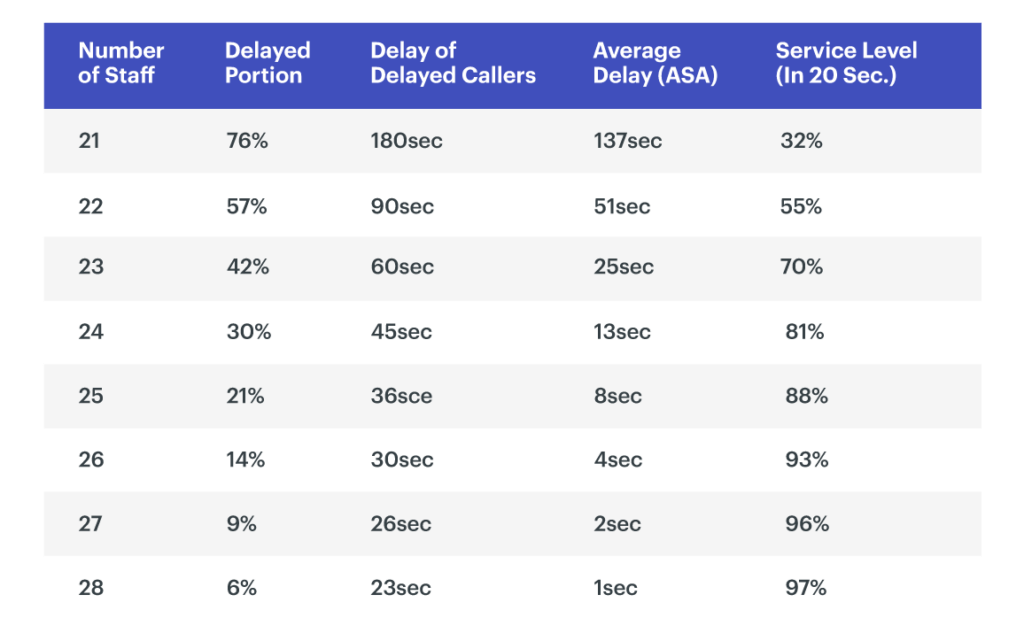Call Center Staffing: How Many Agents Do You Need?
October 19, 2021
Contact Center
Fast-growing companies with ambitious customer service goals and limited resources may find call center staffing tricky — what’s the magic number of agents you need to meet demand and service customers effectively?
Consider what could occur if you have too many or too few agents. Call center staffing with too many agents unnecessarily drives up overhead costs that fall short of demand, and having too few agents makes it far too difficult for your service team to keep up with customers.
Either situation heavily affects the business, so with call center staffing it’s crucial to get as close to the ‘magic number’ as possible and control costs as well as your quality of service.
Calculating the right call center staffing level for your customer service team should rely on a tried-and-true formula. It’s not as simple as dividing the number of call minutes per day by the number of hours in the day, though. As there’s much more to the calculation, you need to gather the appropriate data first. Once you have the right inputs and plus them into an effective formula, you’ve already won half the battle.
All that’s left to do after calculating the number of agents needed is conquer call center attrition so you can stop scrambling to backfill vacancies while trying to build out your customer service team.
Here’s how to calculate the call center staffing level needed for your customer service team and how you can keep turnover low to maintain it.
Erlang C Formula: Balance Customer Service Calls with Call Center Staffing Costs
Erlang C, founded by A.K. Erlang, is a standard formula for determining the number of call center agents needed based on call volume, average handle time (AHT), and your specific customer service goals in terms of service level and target answer time.
But while the formula itself may overwhelm you with all of its variables, an Erlang calculator exists to crunch the numbers for you. You just need to enter the correct numbers to crunch.
If you plug in the wrong numbers such as an impossibly high 100% for maximum occupancy or agent productivity, you’ll either increase up call center costs with no appreciable return or find yourself with too few agents and a lower quality service experience.
The process of determining the number of contacts during a given time period is fairly straightforward, but calculating AHT is somewhat trickier. Here’s the calculation for AHT:
Several factors can distort your AHT, such as the inclusion of shrinkage time — the number of time agents spend on break or in meetings. Handle times can also vary by day part of and by day of the week.
For the sake of accuracy, you need to account for any distinctions and variations that may arise for your business.
A final word of caution: it might be tempting to focus on reducing AHT in the call center to minimize call center staffing levels, but this will negatively impact service quality in other ways. If agents are pushed to end calls as quickly as they can, they will — at the expense of first call resolution (FCR), nurturing the customer relationship, and driving current and future sales.
What Are Your Customer Service Goals?
For the Erlang calculator, you’ll need to set a goal for maximum hold time and the minimum percentage of calls that must be answered within that timeframe.
Using the example above, 80% of calls answered (for service level) within 20 seconds (for target answer time) would require 17 agents according to an Erlang calculator. A more ambitious goal of 90% of calls answered within 10 seconds would require just two additional agents. Call center staffing is about balancing customer service goals with call center staffing costs, so there’s no perfect answer as to which you should choose.
The Erlang C predictions in the chart seen below — based on a 20-hour workload — show how slight variations in front-line call center staffing totals can dramatically impact service quality.
Scaling the customer service team from 21 to 24 agents, for example, eliminates more than half of delayed calls and cuts the customer’s wait time by 75%.

How ambitious should your customer service goals be? We can’t necessarily answer that for you as it depends on a variety of unique factors, but what remains true across every business is that fast responses whether by phone or chat are one of the most important aspects of customer service. Customers expect to have their questions or concerns addressed quickly.
It not only helps to create effortless CX (which leads to higher repurchase rates and customer spend) but also reduces call center costs. The longer the wait time, the likelier customers are to end the call or chat and reach out through another brand channel — hence why average patience (also known as ‘average time to abandon’ or ‘ATA’) is an integral part of the Erlang calculation.
Companies big and small are investing in solutions to respond to customer inquiries in a timely manner. From a competitive standpoint and for the sake of efficiency to meet customers across any channel, minimizing your customers’ wait should be a top priority — call center staffing is a key way to help with this.
Call Center Attrition: The Biggest Cost Driver of All
Scaling a customer service team is complicated enough. Doing so while call center attrition remains high is like taking a step forward and immediately two steps back.
If you’re serious about balancing service quality and operational costs as your business grows (and optimizing both along the way), you can’t pretend that high turnover doesn’t matter. Each new vacancy brings additional hiring and onboarding costs as well as the ramp-up to full productivity that could result in lost sales opportunities and revenue.
You need to reduce call center attrition by focusing on hiring the right people and keeping these agents on your customer service team for a long period of time.
Hiring
Source candidates with qualities that are as important as skills and experience. Career-minded candidates, for example, indicate a long-term commitment to your brand’s culture and values.
Better yet, try to attract and hire candidates who share the qualities of your top-performing agents. You already know what they possess to succeed, and attempting to replicate their qualities with new hires may lead to a cohesive bond between everyone working toward the same goal on the customer service team.
Everyone wants an entire roster of versatile, well-seasoned agents to interact with customers, but ultimately people who align with culture and values are more likely to stay. In the event you find a candidate with less experience but an attitude fit for your brand and your customer service team, it could just be that the attitude wins out because you can always fill gaps in a skillset with training and coaching.
Create ‘personas’ of ideal agents prior to sourcing candidates, and use them as a framework throughout the hiring process. From interviews to assessments, the strongest candidates to join your customer service team will rise to the top and make the decision easy.
Performance Management
Relevant, robust performance management programs give agents the confidence to excel, the motivation to improve, and the opportunity to advance in their career paths. Programs that instead rely on sparse data, internal quality measures, and subjective assessments often have the opposite effect and ruin morale within the customer service team.
In order to separate these two types of programs, turn to data. Real-time customer feedback from the front-line — for micro-coaching, customer-centric training, and more meaningful QA reviews — can transform a customer service team’s culture, efficiency, and value to the entire brand.
Motivation & Engagement
Agents need to feel connected and supported, and they need to believe in what they’re doing. From on-the-spot encouragement and praise to recognition and rewards, there are many tools to use to motivate your customer service team — as long as they’re meaningful from the agent’s point of view.
Companies including Harry’s, Lululemon, and Brooklinen are as invested in their people as they are in creating loyal customers. Why? Because they know that loyal, engaged agents on the front-line are their greatest assets to interact with customers and deliver outstanding service.
As a result, these well-respected brands enjoy the dual competitive advantages of high retention and high customer satisfaction (CSAT) — along with increasing benefits for the top and bottom line.
Empower Agents & Never Think Twice About Call Center Staffing
Call center staffing shouldn’t feel impossible to figure out, especially if you use an Erlang calculator to avoid the trap of guessing how many agents your customer service team needs. It’ll reveal the number of agents that you should employ to control costs while still serving customers within your desired range of service quality.
Ready to ignite agent performance? Check out Medallia’s guide, 4 Steps to Supercharge Contact Center Agent Performance, to learn how leading contact centers are putting the right systems and processes in place to achieve success.










